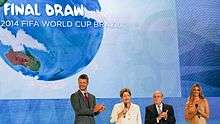2014 FIFA World Cup seeding
The final draw for the 2014 FIFA World Cup took place on 6 December 2013 at the Costa do Sauípe Resort, Mata de São João in Bahia,[1] at 13:00 local time (UTC−3).[2] The ceremony determined the group in which the 32 participating teams will begin the final tournament. The teams have been divided in advance by FIFA into four pots based on seedings and geographic regions.
Seeding

Seeding for the draw is based on the October 2013 version of the FIFA World Ranking.[3] Although the November 2013 rankings were the most current at the time of the final draw, the usage of those rankings would advantage those teams who had played additional play-off matches in order to qualify.[4] Brazil were not among the top eight seeded teams at the time but, in keeping with usual FIFA World Cup procedure, were seeded by virtue of being the host nation.[5] The top seven teams in the October 2013 FIFA World Ranking filled the remaining seeded positions.
| Team | FIFA Ranking October 2013 |
|---|---|
| 11 | |
| 1 | |
| 2 | |
| 3 | |
| 4 | |
| 5 | |
| 6 | |
| 7 | |
| 8 | |
| 9 | |
| 10 | |
| 12 | |
| 13 | |
| 14 | |
| 15 | |
| 16 | |
| 17 | |
| 18 | |
| 19 | |
| 21 | |
| 22 | |
| 23 | |
| 24 | |
| 31 | |
| 32 | |
| 33 | |
| 34 | |
| 44 | |
| 49 | |
| 56 | |
| 57 | |
| 59 |
The draw
In preparation for the final draw, the 32 participating teams were organized into four pots based on seedings and geographic regions. It was announced in October 2013 that the eight seeded teams to feature in Pot 1 would consist of the host nation Brazil and the seven highest-ranked teams as of that month's FIFA World Rankings (see above).[5] Following a meeting of the competition's organising committee on 3 December, the composition of the other three pots was announced:[6]
| Pot 1 (Seeds) | Pot 2 (Africa & South America) | Pot 3 (Asia & North America) | Pot 4 (Europe) |
|---|---|---|---|
|
|
|
|
The draw procedure was as follows:[7]
- One European team was first randomly drawn from Pot 4 and placed into Pot 2, in order to create four even pots of eight teams (in the draw Italy was drawn out).[8]
- The draw then proceeded with the drawing of the other seven seeded teams from Pot 1 into Groups B–H, with Brazil having been predetermined to be in Group A.
- To maximise geographic separation, an ancillary pot ("Pot X") was created during the draw into which the four seeded South American teams (from Pot 1) were placed. One of these four teams was then drawn out (in the draw Uruguay was drawn out).
- The sole European team from Pot 2 was then automatically placed into the group of the South American team that was drawn from "Pot X" (Italy was therefore placed into Uruguay's group); This process prevented three European teams being grouped together.
- All remaining teams were then drawn sequentially from the pots (i.e. Pots 2, 3, then 4) into the groups in alphabetical order (i.e. Group A, then Group B, etc.). During the drawing of Pot 2, groups could be skipped over as the two South American teams in Pot 2 were not permitted to be drawn into the (remaining three) groups headed by South American seeds.
- The positions within the eight groups were then drawn for the non-seeded teams, in order to determine the order of the fixtures within each group. The eight seeded teams were automatically designated the position of Team 1 within their group (e.g. Brazil would be A1).
France seeding controversy
There was some controversy,[9] which some called potgate, before the draw, when FIFA decided that the European team in Pot 2 would be drawn there randomly. Previously, the lowest-ranked European team was sent there. In this case, that would have been France, which wound up escaping the tough draw that befell Italy.
Many officials, fans and journalists complained, pointing out that a Frenchman, the FIFA secretary-general Jérôme Valcke, suggested the change, and suspecting that another influential Frenchman, UEFA’s president, Michel Platini, helped approve it.
The next day, a headline in the Italian sports periodical Corriere dello Sport blared: “2014 World Cup draw: What a scandal!”.[10]
References
- ↑ "Key issues addressed at Brasilia meeting". FIFA. 28 June 2012. Retrieved 23 November 2013.
- ↑ "2014 football World Cup draw to be known December 6". IBN Live. 20 March 2013. Retrieved 23 November 2013.
- ↑ "FIFA sets 2014 seeding parameters". ESPN. 4 October 2013. Retrieved 4 October 2013.
- ↑ "World Cup 2014: England will not be seeded in Brazil next summer". BBC Sport. 17 October 2013. Retrieved 17 October 2013.
- 1 2 "Pot 1 seeds set for Brazil 2014 draws". FIFA. 17 October 2013. Retrieved 23 November 2013.
- ↑ "Draw procedures approved". FIFA. 3 December 2013. Retrieved 3 December 2013.
- ↑ "Final draw procedures" (PDF). FIFA. 3 December 2013. Retrieved 3 December 2013.
- ↑ "Final Draw - Live commentary". FIFA.com. 6 December 2013. Retrieved 6 December 2013.
- ↑ "The World Cup Draw Is Unfair. Here's a Better Way.". The New York Times. 4 June 2014. Retrieved 6 July 2014.
- ↑ "Sorteggi Mondiali 2014, che scandalo!". Corriere dello Sport. 7 December 2013. Retrieved 6 July 2014.